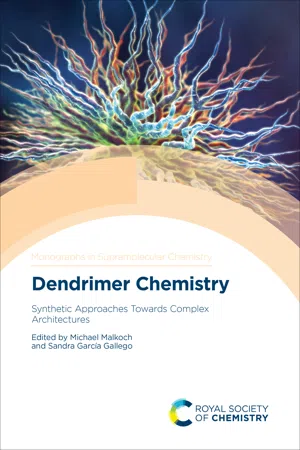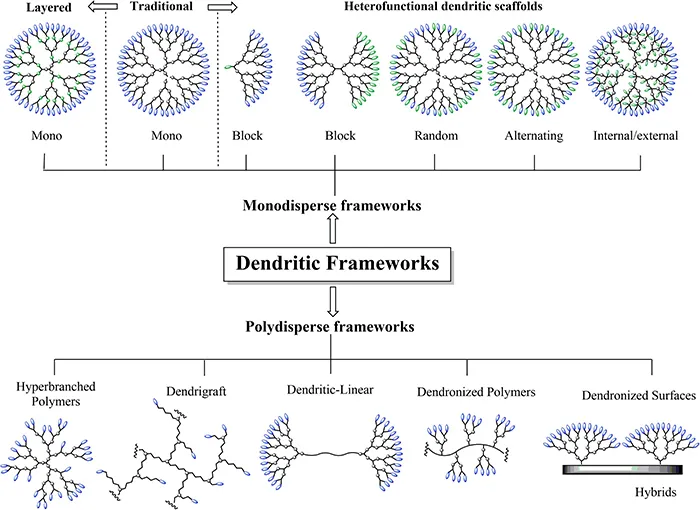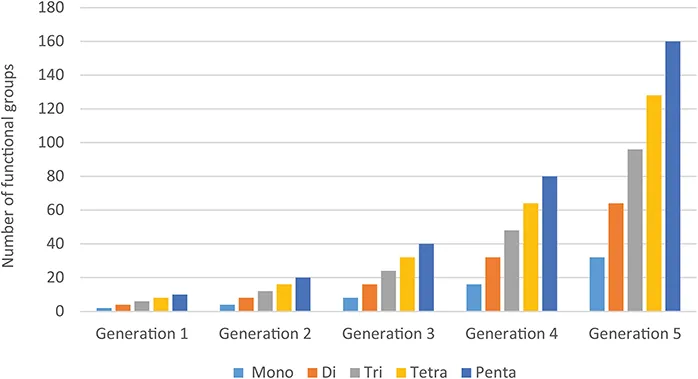![]()
CHAPTER 1
Introduction to Dendrimers and Other Dendritic Polymers
M. Malkoch*a and S. García-Gallego*a , *b
a KTH Royal Institute of Technology, Department of Fibre and Polymer Technology, Division of Coating Technology, Teknikringen 56-58, Stockholm SE-100 44, Sweden,
b University of Alcalá, Department of Organic and Inorganic Chemistry, Faculty of Science, UAH Campus, Alcalá de Henares, Madrid 28805, Spain
*E-mail: [email protected], [email protected] This chapter will provide a descriptive overview of the different classes that define dendritic polymers and their subcategories. These include monodisperse dendrons and dendrimers as well as polydisperse hyperbranched polymers, linear–dendritic copolymer hybrids, dendronized polymers and dendrigrafts. Its content will give the reader interested in venturing into the field of dendritic polymers, the general synthetic options with respect to choice of scaffolds. From a researcher point of view, a major drawback to exploiting this class of polymers is strongly related to their accessibility, especially synthetically challenging and flawless dendritic scaffolds. As monodisperse dendrimers are the pinnacle of dendritic polymers that are synthesized via a cascade of successful reactions steps, it is pivotal that chemists utilize reactions known for their robustness and simple purification. Consequently, a large part of this chapter describes previous and recent synthetic approaches to dendrimers that have successfully been accomplished, such as traditional and accelerated growth strategies, as well as their pros and cons. A rationale on how to synthetically approach dendrimers is provided, from choice of monomers, growth route and pitfalls that accompany their construction. More in-depth synthetic description and their related references for structurally specific architectures can be found in the later chapters in this book.
1.1 Introduction
It is evident that today's high demand for cutting-edge materials is evermore increasing at a rapid pace. This is strongly evident in all scientific communities including the field of polymer science in which the synthetic machineries of polymers have been altered. Independent of area of use, the inherent structure of a polymer has a substantial impact on the material properties in which the polymer is imbedded. Consequently, the progression and advances in structural diversity of polymeric architecture are important steps towards future high-performance materials. In polymer chemistry, precision polymers with well-defined structural control are now proposed with greater pace, e.g. (i) sequence-controlled insertion of the monomers within the main chain, 1,3 (ii) introduction of functional groups in a controlled matter and (iii) polymers that react to external stimuli with great efficiency. 4,5 A direct response to the increased demand for sophisticated macromolecules is found in highly branched dendritic polymers – a subcategory within polymer architectures. These structures belong to the newest addition in the field of polymers and are a result of taking advanced organic chemistry to a macromolecular level. The field of dendritic materials encompasses various subclasses, defined by their structure, such as monodisperse dendrimers and dendrons, as well as polydisperse hyperbranched polymers, dendrigraft polymers, dendronized polymers and linear–dendritic block copolymers (Figure 1.1). In contrast to linear polymers with random coil conformation, highly branched dendritic polymers are condensed frameworks that lack entanglements and therefore display intriguing solution viscosity behaviour with increasing molecular weights. 6,7 Since the first theoretical report by Flory et al. 8 that describes these architectures and later the first successful synthesis of lower generation dendron-like architectures by Vögtle et al., 9 the research on these architectures has been expanding with unprecedented pace. The first full-embodied successful synthesis of regularly branched polymers with monodisperse configurations, later denoted as dendrimers, was reported by Tomalia and coworkers 10 at Dow in the early 1980s in parallel with Newkome's ‘arborol’ systems. 11
Figure 1.1 Overview of the different subclasses of dendritic polymers.
Presently, there are collectively over 27 000 scientific reports and 37 000 patents or patent applications dealing with dendritic structures. Still, potential applications that capitalize on dendritic materials have struggled to be commercialized on a large scale by industry. The main reason is that they are, in the cases of monodisperse scaffolds, exceptionally challenging to construct, leading to extremely high production costs and minimal accessibility for the wider scientific community. Therefore, researchers are continuously providing new synthetic strategies that simplify the development of dendritic polymers and thereby lowering the threshold for their commercial success in cutting-edge applications. 12,15 An overview of definitions and available synthetic strategies to dendritic polymers will be discussed in this chapter. More in-depth synthetic description and their related references for structurally specific architectures can be found in the following chapters in this book. For other established dendrimer families not included in this book, e.g. poly(propyleneimine), poly(arylether), poly(glycerol) and poly(phenylene), the reader is referred to excellent books and reviews in the literature. 7,16,22
1.2 Dendritic Polymers and Their Subcategories
Dendritic architectures can be divided into several sub-groups defined by their structure (dendrons, dendrimers, hyperbranched polymers, etc.), dispersity (monodisperse or polydisperse) or internal linkages (polyethers, polyesters, polyamides, etc.) which are dictated by the monomer of use and chemistry utilized to generate the desired framework. Consequently, a myriad of structures and sizes can be found in the literature. 7 Independently, a logical description can be deciphered for all available structures and below we present a brief summary that describes some of the most important definitions. In Figure 1.1, most architectures are displayed and bundled based on structural perfection. It should be noted that more complex supramolecular structures such as micelles, crosslinked nanogels and networks have also been reported but are not displayed in the figure for simplicity.
1.2.1 Definition of Dendritic Polymers
In contrast to linear polymers, typically based on AB monomers, most dendritic polymers emanate from monomers that enable a non-linear growth, i.e. AB x monomers in which x ≥ 2 allowing for a minimum two directional growth upon the additional of further AB x monomers. As a consequence, highly branched scaffolds are obtained and their size is defined by the number of generations (G) in which the core of use is described as G0 and each complete set of monomers added to the core is titled G1, G2, G3 and so on. This is exemplified in Figure 1.2 displaying a G4 dendrimer emanating from a trifunctional core (B3) and in which an AB2 monomer is the main dendritic building block. The AB2 monomer comprises an A functionality that only can react with the B complementary group, typically via a combination of growth and protective chemistries. Perfectly branched dendritic polymers found in the literature are either dendrons or dendrimers, in which the former is a large constituent of a dendrimer. Definition wise, the dendron wedge can be defined as both a dendron as well as a dendrimer. As a dendron, it will be recognized based on the number of layers of repeating monomer building block. However, as a dendrimer, the first layer, i.e. monomer based on AB2 monomer, can also be considered as the core and in that case the framework will be defined as a didendron dendrimer with a single reactive functionality in the core. Consequently, a G4 dendron can also be defined as a G3 dendrimer, as seen in Figure 1.2.
Figure 1.2 A G4 dendrimer and its constituents.
1.2.2 Effect of the Core and the Monomer on the Number of Functional Groups
It is apparent that for any application-driven research the choice of polymer is strongly dictated by its capacity to carry multiple desired motifs. This is also applicable for dendritic architectures. The large functional group density is one of the most remarkable features of this class of polymers which is influenced by the chosen core as well as the AB x monomer. For instance, choosing a mono-functional core and an AB2 monomer will result in a G5 dendrimer with 32 end groups displayed at the outer layer of a traditional dendrimer. However, by employing a tetra-functional core, the same number of functional groups will be found in a G3 dendrimer. Consequently, a wisely chosen core can eliminate unnecessary reaction steps during the dendrimer growth. In Figure 1.3, the effect of the core, ranging from mono-to pentafunctionality, on the number of functional groups is detailed from G1 to G5. Similar reasoning can be given in the choice of monomer. By utilizing an AB4 instead of an AB2 monomer, the dendrimer will display twice the number of functional groups at the same generation.
Figure 1.3 Core versus functional group density based on generation and AB2 type of monomer.
Importantly, dendritic polymers are considered as condensed frameworks and therefore steric congestion should be taken into account. It is inevitable that with an increased functional density in the core as well as in the monomer a higher rate of probability arises to not fully grow the dendrimer to perfection. To overcome steric challenges, less compact monomers should be targeted providing flexibility and mobility.
1.2.3 Dendrimers, Dendrons and Their Synthesis
The chemistry towards dendrimers and other complex dendritic scaffolds that require structural control of the frameworks has matured since their introduction...



